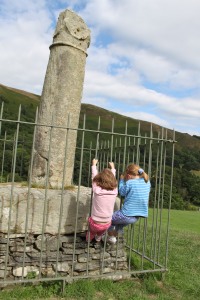
The Pillar of Eliseg was the focus of a recent day out with a family friend. I was proud to show off the early ninth-century cross shaft and pleased to be able to tell her about previous research on the site including the work by Professor Nancy Edwards, and my collaboration with Nancy, Professor Dai Morgan Evans and Dr Gary Robinson in co-directing Project Eliseg.
We dug over three summers, 2010, 2011 and 2012, with the permission of the landowner and Cadw, supported by Llangollen Museum and funded from many sources including Cadw, University of Wales, Bangor University and the University of Chester. I have recently spoken about the interim findings and some broader implications of the project at the Runes Network colloquium in Chester.
Over these three seasons, local volunteers and students from the universities of Bangor and Chester investigated the context of this monument for the first time. We already knew that the Pillar of Eliseg was a fragment of an early medieval sculpted stone cross bearing on its shaft a Latin inscription recording the legendary ancestors of the king of Powys, Concenn, and honouring Concenn’s great-grandfather Eliseg. Importantly, it seems clear that the monument is situated at its original location (a rare thing for early medieval sculpture) on a prominent mound near what was to become the Cistercian house of Valle Crucis Abbey.
I feel our project was a great success. Our finds were modest, but the sequence of activity we revealed, and what we failed to find, were very interesting. The full results of our fieldwork have yet to be produced and post-excavation analysis is still ongoing. Still, already we have been able to add information to the origins of the mound, proving its Bronze Age origins. Also, we have added further information to the biography of mound and sculpture, both in terms of what we have found and in terms of what we have not found. Some of the details can be found in my keynote lecture here. We have kept people informed about our work with a dedicated Facebook site and video blogs on Youtube.

Still, I often feel a mixture of nostalgia and guilt in visiting sites where I have excavated and the Pillar is no exception. Nostalgia even for last summer, and the previous two summers before that, thinking about all the hard work of the volunteers and students, the humour, the chaos, the archaeological discoveries.
Guilt because there is always the sense of the work being incomplete. This is especially true of the Pillar because we have yet to write up and publish the work. Also, there has yet to be a new heritage interpretation of the site. If our dig was an attempt to write the history of the monument anew, we have yet to be successful.
And so, for now, the Pillar remains a prisoner of existing traditions of interpretation. This has a physical component for it, because the Pillar still actually looks and feels like a prisoner. It is protected (or imprisoned) within a high iron fence topped with spikes to prevent damage to the fragile sandstone. It is now encircled by another wooden-post and wire fence and only accessible via a stile hidden from view from the road on its eastern side. The mound is also surrounded by a series of octagonal concreate blocks bearing the initials ‘MOW’ that demarcate what was imagined (somewhat inaccurately) to be the Scheduled Monument. These ‘defences’ feel like prison walls, restricting the monument from its landscape context and preventing it from interacting with it. They reflect an out-moded era of heritage protection and interpretation. Almost like a prison warden overseeing this fence is the Ministry of Works metal signboard, white letters on grey. Itself a piece of the biography of the site, it watches over interpretations, constricting them in a stranglehold.

This was Eliseg’s Pillar it tells us. It says nothing of the fact that it was probably not a pillar, but a cross. It says nothing about the fact that many names appear on the Latin inscription including the king who commissioned it, Concenn. It is his ‘pillar’ too. It might not even be ‘Eliseg’ but ‘Elise’ who is named on the monument. It is equally the Pillar of Maximus of Britain, the Pillar of Vortigern, the Pillar of Britu. It says nothing of the mound and its date. Now we know for sure it was the burial place of far older people who lived in this landscape around 4,000 years ago. It is their monument too, even if the Pillar wasn’t yet there! It says nothing about the inscription on the other side: the pillar as it looks today is the work of the local squire Trevor Lloyd of Trevor Hall. It is Lloyd’s Pillar if it is anyone’s.

Hence my feeling of guilt and failure. Unwarranted, since work is still ongoing. There is no real need to feel so gloomy. Yet to date, our prison break on the Pillar of Eliseg has been a failure. Rather than digging out, we were digging in to free it and while the real digging is over, our intellectual digging is ongoing. Our publications and future plans for the heritage interpretation of the site may still set the monument free of its current shackles. But the job has still to be done…
So onwards we must go, to dig for freedom! There remains much to do and I hope to keep you posted about how things work out. What new discoveries are to be revealed in the post-excavation analysis of the stratigraphy and the finds? What new insights will come from comparison with other sites and landscapes? Only time will tell…
